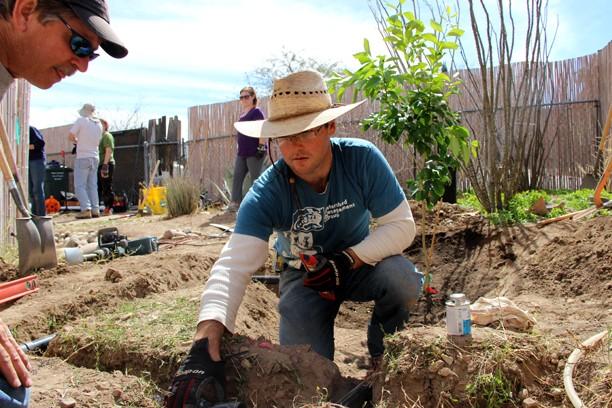Students at the UA are getting their hands dirty in an effort to conserve the most precious resource in the desert: water.
Working in a hands-on environment, students are learning the principles of rainwater harvesting in a course led by Hazel Cox, an adjunct professor with the department of soil, water and environmental science.
For a class project, Cox’s water harvesting class is evaluating several sites on campus to install a water system. Two promising sites are located just south of campus. One is a parking structure that is slated for construction near the Student Recreation Center on East Seventh Street, and the other is near the UA greenhouses on the corner of East Eighth Street and North Fremont Avenue.
Rainwater harvesting is usually used for irrigation, but can also be used for other purposes such as erosion control or even drinking water.
“It turns water issues into water sources,” Cox said.
Last year, students used water harvesting techniques around Old Main to combat flooding. During heavy rains, water would come off the roof and pool around the foundation of the building. The water would then seep into the basement and flood it. The group solved the problem by grading the landscape away from the building, and diverting the water to shallow basins around already present trees.
“It caused the water, instead of pooling around the building, to move away and water the trees,” Cox said.
This kind of multi-purpose solution to a complex problem is a common theme of water harvesting, but the science behind it is simple, according to Cox.
There are two types of rainwater harvesting: active and passive. Active water harvesting, according to Cox, is done by capturing water, off a roof for example, and storing it in a cistern, a waterproof barrel. Passive water harvesting is done by shaping a landscape to direct water to planted areas. Earthwork berms and basins are created and lined with rocks to reduce erosion. The water harvesting course focuses more on the passive form, she said.
In a large dirt basin between North Campbell Avenue and the College of Nursing building, Cox and her students can practice.
“I really enjoy it,” said Melanie Martin, an environmental science senior and a student in Cox’s course. “I like the hands-on aspect of it, and it’s really informative.”
Martin said she thinks it’s extremely important for those in the Southwest to conserve water and that water harvesting is a great way to do it.
“We won’t have to use city water that we use for drinking to water the plants if we use what comes from the sky to water the plants,” Martin added.
Water harvesting can also be done at home and is not too expensive a process, according to Joe Silins, who works for the Watershed Management Group and hosts water harvesting workshops in Tucson.
“These are simple and affordable techniques that we focus on that pretty much anyone can get into,” Silins said. “I think it’s great that students get the opportunity to improve their campus in a hands-on capacity, letting them leave a mark beyond their tenure at the university.”









